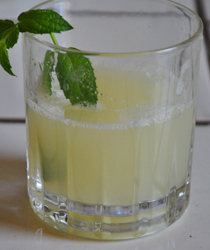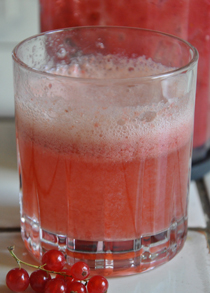Every Thing Is Everything
July 22, 2010. Make your own soda and you can dramatically improve your health, save money and save planetary wear and tear.
Industrial bottled soda’s a prime example of a bad thing being being bad in every way. Worse for your health. More expensive. A fast track to ballooning waists and health care costs; and, a huge waste of oil and gasoline.
Cost Comparison
Water. Seltzer. Soda.
Let’s start with tap water vs. bottled water. Drinking bottled water has an environmental impact 285 times greater than drinking tap water. It’s the greenhouse gas emissions associated with making and transporting all those plastic bottles. What about your personal out-of-pocket cost? Well, tap water’s practically free; bottled water, not close to free. Water quality? Get a good filter – your drinking water will be better than most bottled waters.
Want bubbles?
Blow your own. Get a soda siphon; fill it with your filtered tap water; carbonate it with a small, cheap, recyclable carbon dioxide cartridge. The freshest and best sparkling water in town.
Want a tasty soda – without the really negative health consequences?
Mix up some great flavors with perfectly healthy ingredients; squirt in some of the bubbly water you just made. You’ll be amazed.
I know this sounds like a great idea – but if it doesn’t taste great, it’s just an idea – not a solution. So I’m going to give you another taste every week until you get hooked on one. This is a healthy addiction that really can replace a very, very unhealthy one.
Before I tell you how cool it is to make better, cheaper soft drinks, let me tell you why you should take every opportunity to rid your diet of high-fructose corn syrup (HFCS), the second ingredient (after water) in non-diet sodas.
The onset of the obesity and diabetes epidemic dates back to the late 1970s – the beginning of 25 years that saw America’s annual per person consumption of processed sweeteners, mostly HFCS, increase by 30 pounds. 30 pounds a year of this stuff! Your body deals with HFCS in part by storing it as fat and raising your level of triglycerides (the really “bad” fats), a greater risk factor for heart disease than cholesterol. Not to mention obesity and Type 2 diabetes.
You really shouldn’t drink this stuff. Your kids really shouldn’t drink this stuff.
The BetterCheaperSlower Soda Lab
So I’m dedicating a day a week to coming up with really good alternatives. Whether you’re looking for a soda substitute or a really cool non-alcoholic drink to pair with good food – I’m working on it. Let’s start with an easy one: fresh, homemade ginger ale.
Ingredients
Your filtered tap water with your own bubbles. Fresh ginger. Fresh lemon juice. Pure maple syrup. Here’s how you do it:
What do you get: Ginger Ale on steroids. Talk about refreshing – bottled ginger ale tastes lame after you’ve had your own. Fresh puts the pop in soda.
It really only takes a very few minutes to make from scratch. Squeeze some lemons; slice some ginger; put it in a mini-blender with some maple syrup; press play and wait 20 seconds.
These are the proportions I used for this “test” batch: 1/2 tablespoon of sliced ginger; the juice of 2 small lemons; 3 teaspoons of maple syrup. So start small and add a little of this or that until you’ve got it just right for your tongue.
Note: This stuff is super-concentrated; you’re tasting to get the right balance of sweet and sharp. The next step is mixing this flavor base with your bubbly water. Add small shots of your seltzer until you have your perfect version of ginger ale.
How long will it last?
This is just the beginning of a beautiful thing and I hope it’s habit-forming for you. But if you’re wondering about refrigeration, yes, you can make a big batch of ginger ale base and refrigerate it for a week or two in a sealed container. The soda water? The siphon I use must be absolutely airtight. I’ve left it in the fridge for three weeks; taken it out to give it ten quick shakes; and gotten water as sparkling and fizzy as the day I made it. Another thing to know: this soda water has the tiniest bubbles you can imagine. You can’t even see most of them – you just feel this carpet of sparkle on your tongue.
Want to see how the soda siphon works?
Cost-Benefit Analysis
The CDC notes, “Since the mid-seventies, the prevalence of overweight and obesity has increased sharply for both adults and children.”
Well, what’s changed since the 1970s? The American Journal of Preventive Medicine tells us, “For all age groups, sweetened beverage consumption increased and milk consumption decreased. Overall, energy intake from sweetened beverages increased 135% and was reduced by 38% from milk, with a 278 total [daily] calorie increase.”
The U.S. Dept. of Agriculture’s (USDA) Economic Research Service looked at just fifteen years and found “A big jump in average calorie intake between 1985 and 2000 … Of that 300-calorie increase, grains (mainly refined grains [especially corn for HFCS]) accounted for 46 percent; added sugars, 23 percent … the meat and dairy groups together, declined by 1 percent”.
Yes, most of the daily calorie increase came from food products – largely colas and other sodas and drinks – based on high-fructose corn syrup.
Bottled sodas and colas: profoundly high cost, no benefit.
But it tastes good; it’s refreshing. Yeah, I’ve seen the commercials, too. I’m just sayin’ … try some of this on for taste:
Red Currant soda sweetened with brown sugar and blackstrap molasses
Better: You choose the ingredients; you get exactly what you want and none of the stuff you don’t want.
Cheaper: Save more than 50% compared to the price of bottled soda in the supermarket. Save the planet: no more cans and bottles – and driving them halfway across the country.
Slower: Watching it happen – in seconds – is a great new source of free home entertainment. Kids and friends will marvel at it. You’ll concoct and slowly sip tasty beverages perfectly matched to your favorite foods.

